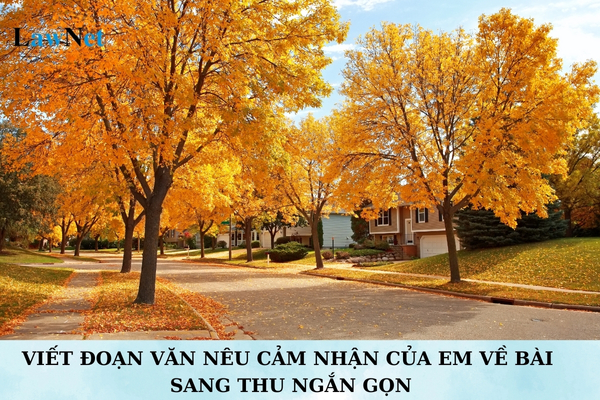What are the sample paragraphs on your impressions of the poem "Sang thu" for 7th-grade students? What is the distribution of Vietnamese knowledge circuits at each educational level?
What are the sample paragraphs on your impressions of the poem "Sang thu" for 7th-grade students in Vietnam?
Students can refer to the following sample paragraphs on your impressions of the poem "Sang thu":
|
Sample paragraphs on your impressions of the poem "Sang thu"
Sample 1
The poem “Sang thu” by Huu Thinh paints a delicate and vivid picture of nature as autumn knocks on the door, bringing gentle transitions from summer to autumn. It begins with the scent of ripe guavas wafting in the cool breeze, a rustic and familiar image signaling autumn’s arrival in the familiar countryside space. The "chùng chình" mist through the alley evokes a sense of slowness and hesitation, still lingering in summer. The rivers leisurely flow in contrast to the "vội vã" flight of birds. Notably, the image of the "summer cloud half crossing into autumn" is both subtle and vividly portrays the seasonal transition. The last stanza depicts the changes in nature: the golden sun is no longer harsh, the rains are decreasing, and thunder is no longer surprising. The image of "mature trees" evokes experience and calmness before the changes of time. Through the poem, Huu Thinh shows sensitivity to nature while conveying a philosophy about the transformation of life: gentle, serene yet profoundly deep. “Sang thu” makes readers cherish the moments of seasonal transition and appreciate the subtle changes in life.
Sample 2
Every time I read “Sang thu” by Huu Thinh, I am overwhelmed with an indescribable emotion by the gentle beauty of nature during the seasonal transition. The poem begins with very familiar signals of Vietnamese countryside: the "scent of guava" wafting in the cool early autumn breeze, "mist hesitating through the alley" as if reluctant to leave summer. These images evoke a peaceful, quiet space. The subtle contrast between the leisurely river and the hurried flight of birds creates a lively and evocative picture of nature. The poet not only describes the scenery with a keen eye but also embeds deep reflections on time and life. Through the image of "thunder becomes less surprising" on "mature trees," we perceive the maturity and experience of people when they have passed through life's violent upheavals. “Sang thu” is not only a beautiful picture of seasonal transition but also a gentle song about change and maturity before the flow of time.
Sample 3
The poem "Sang thu" by Huu Thinh offers readers a refined view of the moment when summer transitions into autumn. Without grandiose or noisy images, autumn arrives in Huu Thinh's poetry gently and simply through the "scent of guava" in the wind or the "hesitating mist" still lingering at the threshold of time. The poet skillfully captures the transformation of the earth and sky through each small and familiar detail. The river slows down, birds start flying hurriedly, and the summer clouds linger as "half crosses into autumn." This intersection is both specific and evokes deep reflections on life. In the final stanza, the sunlight and rains become milder, and thunder is no longer as intense as before, signaling a maturity. The scenery in the poetry reflects the human soul: after the vibrations and noise of youth comes calmness and experience as one enters a new phase of life. “Sang thu” is gentle yet profound, making us love nature's changes and cherish every still moment of life.
|
Note: The information is for reference only.

What are the sample paragraphs on your impressions of the poem "Sang thu" for 7th-grade students in Vietnam? What is the distribution of Vietnamese knowledge circuits at each educational level? (Image from the Internet)
What is the distribution of Vietnamese knowledge circuits at each educational level?
Under sub-section 1.2 Section V of the General Education Program in Literature issued together with Circular 32/2018/TT-BGDDT, the distribution of Vietnamese knowledge circuits at each educational level is as follows:
- Primary Level: some basic knowledge of phonetics, writing, vocabulary, grammar, communication activities, and language variations (language combined with images, data); ability to recognize and initially understand related linguistic phenomena and apply in communication.
- Lower secondary level: basic understanding of vocabulary, grammar, communication activities, language development, and variations (local dialects, social slangs; language combined with images, data, charts, diagrams) to help students understand related linguistic phenomena and apply them in communication.
- Upper secondary level: advanced understanding of Vietnamese helps students to understand, analyze, and initially evaluate related linguistic phenomena, focusing on creative expressions and using language in research reports and communication.
What is the minimum teaching equipment required for Literature in Vietnam?
Under sub-section III Section VIII of the General Education Program in Literature issued together with Circular 32/2018/TT-BGDDT, the regulation on minimum teaching equipment for Literature is as follows:
- The minimum teaching equipment for Literature is a reference library, containing various types of major texts including literary, argumentative, and informational texts; and different forms such as storybooks and comic books.
- In each major text type, there are subtypes: literary texts include stories, poems, plays, and prose; argumentative texts include literary arguments and social arguments; informational texts comprise explanatory and utilitarian documents. Various pictures such as portraits of major writers included in the program; illustrated pictures for the content and art of significant works such as "Nam quốc sơn hà", "Hịch tướng sĩ", "Bình Ngô đại cáo", "Truyện Kiều", 'Văn tế nghĩa sĩ Cần Giuộc", "Tuyên ngôn Độc lập", etc.


